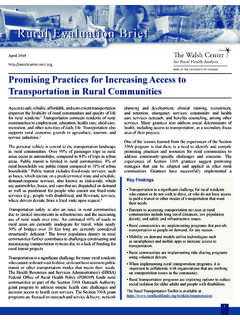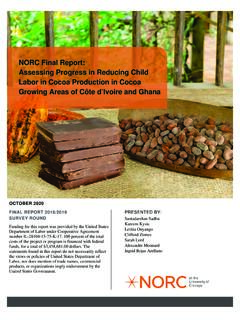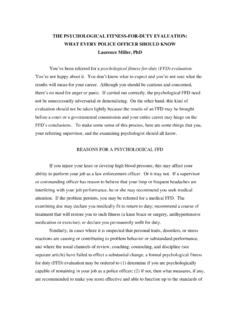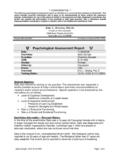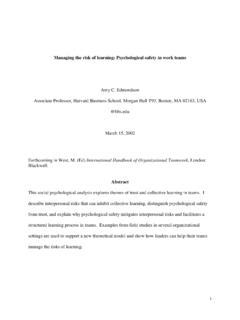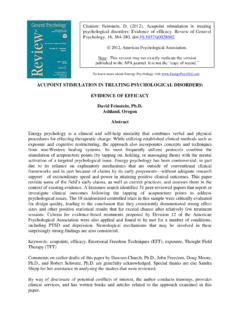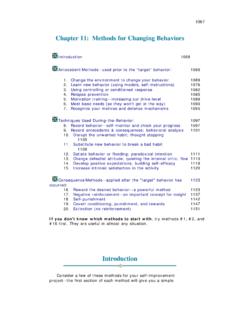Transcription of The Structure of Psychological Well-Being - …
1 The Structure of Psychological Well-Being norc 1 NATIONAL OPINION RESEARCH CENTER MONOGRAPHS IN SOCIAL RESEARCH 1. JAMES A. DAVIS / Great Aspirations 2. JAMES A. DAVIS / Undergraduate Career Decisions 3. NORMAN M. BRADBURN AND DAVID CAPLOVITZ/ Reports on Happiness 4. JOHN W. C. JOHNSTONE AND RAMON J. RIVERA/ Volunteers for Learning 5. JAMES A. DAVIS / Education for Positive Mental Health 6. ANDREW M. GREELEY AND PETER H. ROSSI / The Education of Catholic Americans 7. SEYMOUR WARKOV / Lawyers in the Making 8. THEODORE M. NEWCOMB AND EVERETT K. WILSON (ED%)/ College Peer Groups 9. WALTER L. WALLACE / Student Culture 10. SEYMOUR SUDMAN / Reducing the Cost of Surveys 11. JACOB J. FELDMAN / The Dissemination of Health Information 12. PETER H. ROSSI AND BRUCE J. RIDDLE (EDS.)/ The New Media and Education 13.
2 ANDREW M. GREELEY / The Changing Catholic College 14. ROBERT L. CRAIN / The Politics ofSchool Desegregation 15. NORMAN M. BRADBURN / The Structure of Psy chological Well-Being The Structure of Psychological Well-Being BY NORMAN M. BRADBURN With the assistance of C. EDWARD NOLL ALDINE PUBLISHING COMPANY Chicago Tlris inve~tigcrtiort WUJ supported irr pcrrf by Public Health Service Grant MH09183 front fhr Narjon~l Itrstifrrlr of Menfnl Henlth CopyriglrP 1969 by Nutiontrl Opinion Rexarch Center All right3 No part of this publication may be reproduced or trurrsmitted in urry form or by any means, electronic or mechanical, including photocopy, recording, or any infortncrtion forage and retrieval system, withorit prrmr.\\ion in writing from the r~rrhlither. First puhlislred 1969 by ALDINE P~rblislring Company 529 South Wabash Avenue Chicago, Illi~tois 60605 Librury of Congre~~ Crrtcrlog Curd ,Vutrther 67-27388 Designed by Grerr Alletr Printed irr the, Utritrd Stutec of Atrrrrictr Preface Sir Isaiah Berlin has observed that there are deep differences in the ways in which people approach life, and that it may be useful to think of these ways as falling into two large groups-the way of the hedgehog and the way of the fox.
3 Hedgehogs approach problems in an integrative manner, trying to bring everything into a single, universal, organizing principle that gives unity to the manifest diversities of life. Foxes, on the other hand, approach problems in a differentiating manner and pursue many disparate problems with little concern for haw they fit together or might fit into a larger integrated whole. Hedgehogs look for the unity in diversity; foxes look for the diversity that underlies the unity. In the field of mental health, the split between hedgehogs and foxes roughly parallels that between theorists and empiricists. The grand theorists such as Freud and Jung were militant hedgehogs. However, a review of the empirical literature in mental health, such as that by Jahoda (1958), shows the field to be dominated by foxes.
4 This unfortunate split between hedgehog-theorists and fox-empiricists has resulted in unifying theories that dangerously approach explaining everything, and thus explaining nothing, or in disparate empirical findings that do not add up to anything. Too often theories are divorced from data, and data are collected with little regard for their theoretical import. This book is a hedgehog's attempt to bridge that gap and pursue systematic data collection within the framework of a single unifying concept. This concept- Psychological Well-Being , or hap- piness-has been of great concern to men since recorded history began and has been the object of vast amounts of thought and research for centuries. It is a logical concept to employ in the study of phenomena related to current concerns with mental health and mental illness, and one that is very congenial to the hedgehog mind.
5 The particular conception of Psychological Well-Being that is elaborated in this monograph emerges from a pilot study con- ducted by NORC (Bradburn and Caplovitz. 1965), which vi Preface attempted to develop instruments for measuring mental health in the population. Analysis of the data from that study led to a conceptualization of Psychological Well-Being as a resultant of two almost completely unrelated dimensions of affect, which we called positive and negative feelings. The results of that study were suf- ficiently encouraging to suggest that further research along these lines would be productive. At the conclusion of our pilot study, we noted four main areas for future research: (1) replication of the basic findings regard- ing the independence of the two dimensions related to Well-Being and the correlates of these dimensions; (2) systematic investigation of the stability over time of the measures of affect and the condi- tions that contribute toward their increase or decrease; (3) further investigation of the correlates of positive affect; and (4) determi- nation of the conditions that produce changes in different aspects of the two dimensions.
6 The study reported in this monograph contributes new data to each of these four areas of concern. We have not, of course, solved all of the problems implied in these questions; but this study does represent some progress along the road to providing adequate answers for them. NORMAN M. BRADBURN Wellfleet, Massachusetts July, 1968 Acknowledgments The study reported in this volume was begun in 1962 and has benefited from the advice and help of many people. I am deeply indebted to Peter H. Rossi and Jacob J. Feldman, both formerly at NORC, who first interested me in the project and whose stimu- lating ideas and warm encouragement were extremely helpful during the design phase of the study. Richard H. Williams and James G. Kelly of the National Institute of Mental Health enabled us to extend the scope of our original plans and to coordinate our data-collection operation with that of NIMH's Mental Health Study Center.
7 Their efforts and thc cooperation of the staff of the Study Center greatly aided us in carrying out the study. My former colleague at NORC, David Caplovitz, worked closely with me during the early part of the project, as well as on the pilot study. His unflagging enthusiasm spurred us on whenever things threatened to become bogged down in a mass of detail. Much of Chapter 2 is drawn from a preliminary report for which he was primarily responsible (Caplovitz and Bradburn, 1964). Eleanor Hall, William M. Mason, C. Edward Noll, Susan R. Orden, and Anthony M. Orum constituted thc research staff who worked on the project. Each made a distinct contribution to the analysis of the data and worked many long hours preparing tables, checking results, and pursuing hypotheses, many of which led to fruitful results and separatc publications.
8 An empirical survey of the magnitude and complexity of the onc reported here cannot be carried out without the assistance of a large and expert interviewing staff. I am particularly indebted to Eve Weinberg, NORC's Field Director, who was in overall charge of the interviewing, to Miriam Clarke, who supervised the Wash- ington interviewers, and to Helen Colditz, who supervised the Detroit interviewers, as well as to all of the interviewers who worked for over a year in carrying out their voluminous inter- viewing assignments. Many others on the NORC staff contributed to the success of the study, particularly Mary McGlasson, who carried out the sam- Acknowledgments pling plan, James C. Beckwith, who devised the programs that enabled us to process panel data efficiently and to compute the statistics we needed, Carl McGee, who expertly produced the tables from our sometimes-cryptic run orders, Nella Siefert, who typed many, many drafts of the manuscript, and Mary A.
9 Spaeth, who edited the final manuscript and prepared the index. I am also indebted to Bruce Dohrenwend, Sheila Feld, Joseph Noel, and Warner Wilson, and to my colleagues at the University of Chicago, Donald W. Fiske, L. Richard Hoffman, John W. C. Johnstone, and Seymour Sudman, who read various versions of the manuscript and contributed many valuable suggestions. I am particularly grateful to my former colleague at NORC, James A. Davis, and to John H. Hamlin for their detailed reading of the manuscript. Needless to say, the book has been considerably improved by their insightful constructive criticisms. Portions of two chapters in this monograph have appeared else- where in somewhat different versions. I wish to acknowledge per- mission to use these materials granted by Stanford University Press and the University of Chicago Press.
10 Finally, 1 would like to express my thanks to my administrative assistant, Rita Hinckley, and to my wife, who both performed that most valuable service to any author-they kept people away. Contents v vii xi Preface Acknowledgments List of Tables CHAPTER 1. On Psychological Well-Being 2. Study Design and Methods of Analysis 3. Self-Reports of Happiness 4. Two Dimensions of Psychological Well-Being : Positive and Negative Affect 5. Stability and Change in the Affect Measures 6. Social Status, Income, and Psychological Well-Being 7. Anxiety, Health, and Negative Affect 8. Social Participation, Novelty, and Positive Aflect 9. Adjustment in Major Roles. I: Marriage 10. Adjustment in Major Roles. 11: Work / c. EDWARD NOLL 11. Social Trauma: The Assassination of President Kennedy 12.

